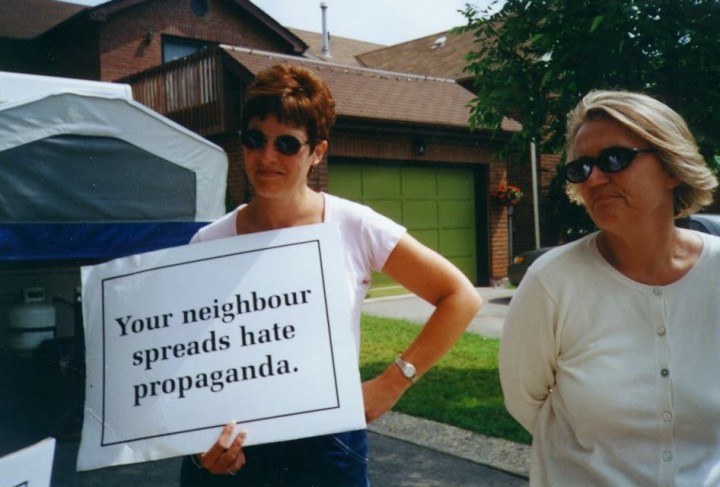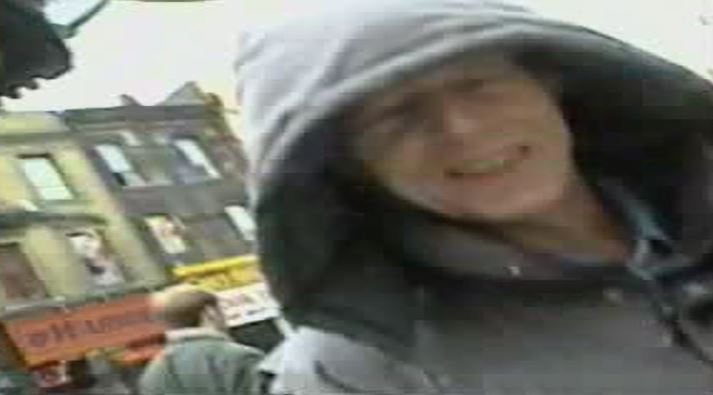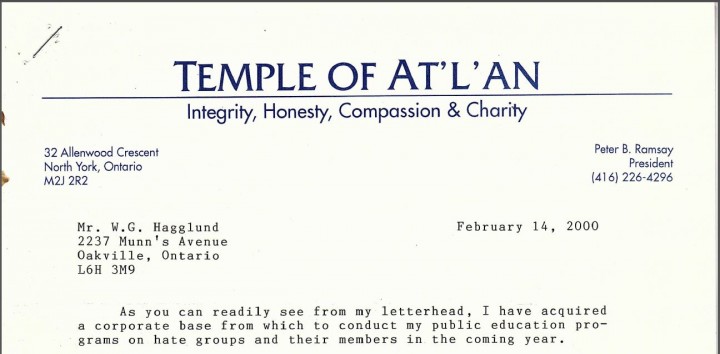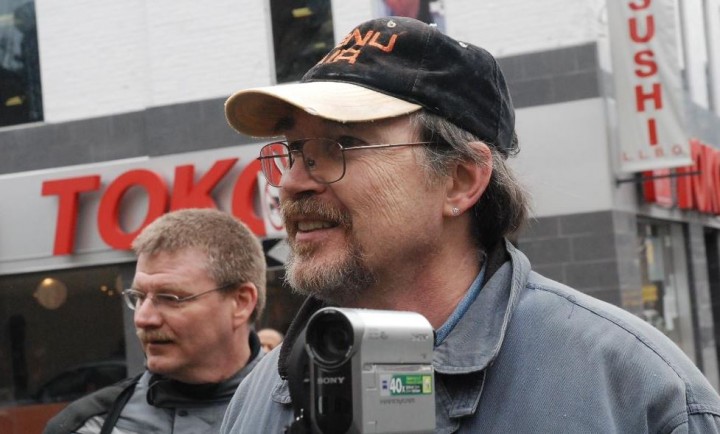Scientology founder L. Ron Hubbard first announced a “Fair Game Law” in 1965 at a time when he was writing policies to crack down on splinter groups that infuriated him. A decade earlier, he had made it clear that Scientology was not a “turn the other cheek” organization. In 1955 for example, he encouraged the use of litigation to attack people he considered enemies: “The purpose of the suit is to harass and discourage rather than to win. The law can be used easily to harass, and enough harassment on somebody who is simply on the thin edge anyway, well knowing that he is not authorized, will generally be sufficient to cause his professional decease. If possible, of course, ruin him utterly.” Four years later, he wrote, “People attack Scientology. I never forget it, always even the score.”
In its earliest forms, Hubbard explained that by “Fair Game” he meant that anyone who had been expelled by the group could not expect its subsequent protection. But then, in 1967, Hubbard gave his most notorious definition of what he meant by the policy, writing that Scientology’s enemies may be “deprived of property or injured by any means by any Scientologist without any discipline of the Scientologist. May be tricked, sued or lied to or destroyed.”
Scientology denies that it engages in Fair Game today. It says that the Fair Game policy was canceled by Hubbard in 1968. But astute observers have noted that in his 1968 order Hubbard actually said, “The practice of declaring people FAIR GAME will cease. FAIR GAME may not appear on any Ethics Order. It causes bad public relations. This does not cancel any policy on the treatment or handling of an SP.”
In other words, the policy of ruining “SPs” utterly and destroying people would continue, so long as the words “Fair Game” weren’t involved.
Even Scientologists themselves ignore this rule, using the words Fair Game as naturally as they would “disconnection” or “shattering suppression” or the other jargon that describes Scientology’s harsh ideas about discipline and control. And the threat of such treatment is very real. Those still in the church have told us they fear making their disaffection public for fear that they will be subjected to a Fair Game campaign.
In 1997, when Gregg Hagglund began his pickets and then submitted his documents opposing Scientology’s application for charity status, he began receiving death threats online that he was able to trace to IP addresses controlled by OSA.
“I was allowed to buy a Kevlar vest from police suppliers with police knowledge and assent. I was urged to wear it whenever I went out, especially to picket,” he says.
Rob Ramsay tells us that by 1997 his brother Peter was divorced and had moved back in with their mother after their father had died. In 1975, Peter and a friend, Dave Stokes, had used their experience working contractor jobs to start their own roofing company. Avenue Road Roofing became a success, and Ian says his brother’s company was making millions each year. But by this time, he says, Peter had walked away from it.
Peter apparently had a lot of time to spend on his newest project: Following Gregg Hagglund. And he took meticulous notes, which we found in his papers.
On July 26, 1997, Ramsay submitted a report to his OSA handlers reporting on his personal surveillance of the Hagglund home.
“I drove out to the house on three separate occasions during this period — once to locate the house, once to get plate numbers and one final time to get photos of the home and vehicles,” he writes. Ramsay described the neighborhood and the house, assessing how surveillance could best be done on it. He noted the lack of security cameras, and described each of the automobiles.
Ramsay then did a detailed search through old phone books back to 1971 to find as many records of the Hagglunds and who had lived at their past addresses. He found drivers license information for Gregg and Jennifer and their son Christopher. He also looked up mortgage records on their home and ownership documents for their cars.
Around this time, another document shows, Ramsay also began watching Hagglund closely at ARS, and kept notes of Hagglund’s online statements that he considered threats aimed at the church. (Ramsay eventually became a familiar presence at ARS, and jokingly referred to himself as “Clamsay.”)
In both cases, the reports are strained — Ramsay is clearly working diligently, looking for something the church can use against a man who was quickly becoming its biggest problem in Canada. But Ramsay was just an amateur. At one point, he apologizes that he has no way, for example, to do a credit check on the Hagglunds. He’s no private eye.
But then, on May 26, 1998, everything changed.
Peter Ramsay suddenly had Gregg Hagglund served up to him on a platter.
Hagglund’s son Christopher had been charged with a serious crime.
“Christopher was with several young men recruited at their high school to sell weed to other kids. He wanted to have enough money to have product for himself — he felt much better on marijuana than he did on the medication he was on for his ADD,” Gregg Hagglund says. His son was then beaten up over his pot, and he had to be taken to the hospital. He told Gregg what was going on, and also talked to police.
“The cops were very unsympathetic,” Hagglund remembers. When they asked to search his house, Gregg assented. “They found nothing. We thought that was the end of it.” Instead, police arrested several students. Hagglund’s son was the only one who was over 18, so he was the only one named in news reports.
Gregg Hagglund’s son had been charged and publicly named. And Peter Ramsay saw his opening.
In the months following news of Christopher’s arrest, Peter Ramsay completed two additional surveillance reports on the Hagglund family. In September, Ramsay did a detailed search of newspaper clippings, finding stories about the arrest, of course, but also tracking down older pieces about Gregg Hagglund’s Starship Enterprise mock-up at Mr. Gameways’ Ark. Ramsay also found that both Gregg and Jennifer had acted or been involved in other ways in the theater, and he wonders in his report if this might be a “possible line of investigation.” He also found stories about Gregg’s father, Melvin, for his government involvement, and minor stories on several other people who Ramsay suspected may have been related to Gregg or Jennifer.
In October, Ramsay wrote up a detailed look into Hagglund’s business interests, which included the Temple At’L’An and its affiliated groups as well as a theater group that had put on a play. After listing the three companies Hagglund had created for his temple, Ramsay noted: “All three companies are ‘weak points.’ I believe that the Hagglunds would have no corporate protection from lawsuits brought against these three companies and all personal assets not secured by creditors could be seized. A good lawyer or accountant would know for sure. Just a thought.”
Then, two days later, on October 23, 1998, Ramsay sent a letter to the crown attorney, Bob Lush, who was prosecuting Christopher. Ramsay wanted Lush to know that he had information about Gregg Hagglund, who, in Internet postings, referred to himself as a pagan.
I know nothing of the religion called paganism and took the trouble to purchase some basic books on the subject. I was somewhat surprised to find that paganism is very closely allied to witchcraft and shamanism. “Witchcraft” is defined, in the Gage Canadian Dictionary, as “the practices and cult of witches; the power or art of evoking supernatural forces or spirits to control or change the natural course of events, especially in order to work evil.” “Shamanism” is defined as “a religion of the Ural-Altaic peoples of N Asia and Europe, characterized by belief in spirits, demons, and gods that can be influenced only by the shamans [a priest or medicine man].”
I am the last person to criticize someone’s religious beliefs. However, having observed Mr. Hagglund in action, and having determined, at least for myself, that he is, indeed, a practicing pagan, I must admit that alarm bells started to go off.
This brings me to the point of my letter. I have a serious concern in regards to the nature of the home environment of young Mr. Christopher Hagglund.
“I had the letter within a day of the crown getting it. The crown faxed it to my lawyer,” Hagglund says.
Hagglund was stunned that Ramsay would try to insert himself in the case by suggesting that Gregg was a danger to his own son. He called Ramsay, threatening to put the letter on the Internet, and Ramsay hung up on him.
Ramsay then sent him a letter, daring Hagglund to post the letter, and telling him that he thought Hagglund’s allusion to legal action was an empty threat.
I feel, Mr. Hagglund, that you are one of those people who has had a great deal of difficulty in life in creating any kind of good or beneficial effect on your environment. I would guess that, at some time past, you recognized this inability in yourself. Yet you craved, and still crave, some kind of attention, some kind of admiration, some kind of importance. I believe that, lacking the wherewithal to obtain these acknowledgments in any kind of decent and straightforward fashion, you have descended to a level where you can only create bad or destructive effects on those around you.
Lush called the letter immaterial and ignored it. He also ignored Christopher’s case. Hagglund says that after 20 court appearances, a new judge on the case was surprised when Hagglund’s attorney recited all of the delays and non-prosecution. The judge agreed that it was excessive, and said he was ready to dismiss the case. But Hagglund spoke up, saying that he didn’t want his son to walk away without any consequences. So Christopher was sentenced to several hundred hours of community service.
“He made ribbons for MADD and handed them out at meetings. That worked out perfectly. That was it and it was over,” Hagglund says.
Meanwhile, Scientology pushed its program against Hagglund. In February 1999, the Globe and Mail reported that Al Buttnor, the Toronto org spokesman, and an Ottawa official named Cathie Mann had visited Hagglund’s parents in Ottawa unexpectedly. Reported the Globe and Mail‘s Timothy Appleby…
Wilma Hagglund, in her 80s, did not let them in. But she was mindful of Scientology’s reputation as a vigorous opponent, and the encounter left her unnerved.
“I told them that what my son did was his own business and I didn’t want anything to do with it, and they went away.”
Why the visit?
“I think you know why,” Mr. Buttnor said. “It has to do with hatred.”
After that write-up, even some Scientologists were appalled, and secretly reached out to Gregg. He cultivated them as sources.
Mann also paid a visit to Gregg’s brother, Rod. And Peter Ramsay sent Rod a letter.
Hagglund’s parents were deeply upset about the visit by the Scientologists, who had also begun picketing the house where Gregg and Jennifer lived.
When Hagglund picketed the Toronto org each month, Scientology would send over a small group of women to hold signs outside the Hagglund home.
“They were trying to put pressure on me in the neighborhood,” Hagglund says. “It was a ‘troublesome neighbor’ type of thing.”
Hagglund says he came up with a banner to put on his garage: “Scientology is picketing my house because I’m picketing them” — and his neighbors helped him put it up.
The pickets at his house were easy enough to deflect. But in a surprise, the letter from Ramsay to Gregg’s brother Rod seemed to have a lasting effect.
“Shortly after my brother got the letter from Ramsay, my calls to him were blocked. My sister cut me off too,” Hagglund says.
He’s rarely seen them since.
Later that year, Ramsay also targeted two of Hagglund’s picketing colleagues, hoping to get them in trouble with their employers. In a letter to Ron Sharp’s employer, Janna Systems, Ramsay writes at length about Hagglund, and then accuses Sharp of writing harassing things about Scientology at ARS, and of using his business account for some of his statements. Ramsay then says that he plans to hold his own picket at Janna’s building.
Sharp says the letter fit Ramsay’s style. Ramsay exaggerated things for effect, and Sharp was leaving that company soon for another job anyway. So it failed to cause him any trouble.
Meanwhile, OSA wanted a more professional surveillance of the Hagglunds than Ramsay had been able to provide. In October 1999, the org’s Gwen Jones paid $742.28 to an investigations firm named the Corpa Group. A copy of the report was found in Peter Ramsay’s papers. (Gwen is sister to Phil Jones of billboard fame. It was Gwen who informed on her brother Phil and Willie Jones, they say, when they were thinking of leaving Scientology, which got them declared suppressive and disconnected from their kids. Gwen Jones is still in Scientology today.)
Corpa Group found what the Hagglunds had paid for their house in Oakville, the balances on their credit cards, their record of court litigation and prison (which were each nonexistent), and the names of the corporate entities Gregg had created for the Temple of At’L’An.
And, at the end of the report, which had found nothing damaging or even particularly unusual about the Hagglunds, who had no criminal past or even very much in the way of debt, the Corpa Group provided a telling conclusion:
“It would seem that background inquiries have not aided in discrediting the subject.”
There was little in Gregg Hagglund’s past that the church could exploit. But soon enough, Peter Ramsay had come up with a creative way to mess with the Hagglunds.
On Valentines Day in the year 2000, Ramsay mailed a long letter on letterhead that must have given Hagglund a shock. Across the top, it read “Temple of At’L’An: Integrity, Honesty, Compassion, and Charity.” And it listed Peter B. Ramsay as its president.
“You can readily see from my letterhead,” Ramsay wrote, “I have acquired a corporate base from which to conduct my public education programs on hate groups and their members in the coming year.”
The “Temple of At’L’An Inc.” came into existence, quite legally I might add, on January 24 of this year. The Ontario corporation number is 1398098. I am the sole director of the corporation and, I am proud to say, hold the presidency.
The new corporation will operate under the name “Temple of At’L’An.” I shall also be taking steps to trademark the corporate name. This not expensive but rather lengthy process (I’m told it can take up to nine months to complete) is a necessary investment of money. I have it on good authority that by trademarking the corporate operating name I arm myself with irrefutable legal remedies against those who would damage it either by using it for their own business pursuits or by using it in conjunction with activities that would, by their very nature, bring dispute upon my corporation.
Perhaps you should begin to make other arrangements.
Ramsay claimed that he had co-opted Hagglund’s own company name, and was going to use his Temple of At’L’An to raise awareness about religious bigots like Gregg Hagglund. He then went on for ten typewritten pages accusing Hagglund of the litany of transgressions Ramsay imagined Hagglund had committed.
“It appears to me, from a review of photographs taken of you over a three-year period, that you are not in good health. One can only guess at your current mental health,” Ramsay wrote.
If you choose to persist in your hateful activities I fear that life will only get worse for you and through no hand other than your own. The events of the past year should be enough proof of that for you. Where you attempted to break apart our family, it was your own family that went asunder. Where you attempted to degrade your children, it was your own child who became degraded. Where you attempted to set yourself up as a figure of fear, it was you who became fearful…It’s time for you to take a long, hard look in the mirror.
Peter Ramsay
President
Temple of At’L’An Inc.
Hagglund says that Ramsay, in his desire to disrupt Hagglund’s life, had taken a misstep.
“We had already registered the temple as a business name and trademarked it,” Hagglund says, and he quickly concluded that Ramsay was just trying to bait him into suing him. “They wanted to get me into court and waste my resources,” he says. “But trademarks are federal. I didn’t have to sue him. My lawyer wrote a letter and it was the job of the feds to enforce it.”
Hagglund responded to Ramsay’s letter, telling him that he didn’t have the right to use the temple’s name.
“The next time he used it, my attorney sent a letter directly to Scientology with proof that Ramsay was acting on their behalf. We threatened to sue the church,” he says. “And in federal court, they wouldn’t stand a chance. Scientology would face an injunction, and that would make the press. I never heard another word about Temple At’L’An from that asshole again.”
As the year 2000 continued, Peter Ramsay found yet another way to “impinge” upon Hagglund, as Scientologists say.
Twice, in the spring, Hagglund had found Ramsay waiting for him in parking lots where he was preparing to picket. The first time, Hagglund called the police, who gave Ramsay a warning. The second time, Hagglund managed to elude Ramsay before he was seen.
Then, on the afternoon of April 28, a Friday, Hagglund spotted Ramsay waiting for him near a coffee shop where he planned to meet some friends before heading to a bookstore where John Travolta would be signing autographs to promote the movie Battlefield Earth.
This time, Ramsay got in Hagglund’s face quickly, saying “I’m going to be all over you today” and repeatedly calling Hagglund a “child abuser.” When Hagglund tried to avoid him, Ramsay blocked his way and then chest-butted him, Gregg later told police in a sworn statement. Ramsay also threw a punch at his stomach and jabbed his finger in Hagglund’s mouth. Ramsay then hurried off before police could arrive.
But Hagglund says he especially appreciated how the police handled the matter.
“They took us to Travolta’s signing. They drove us to the bookstore, and then they got out and took our picket signs out of the trunk and gave them to us,” Hagglund says with a laugh.
That same month, Gregg’s father Melvin died. At the funeral, Gregg says he tried to talk to his brother, who turned away from him. Overwhelmed by his father’s death, and the harassment campaign he’d been going through for three years, Gregg experienced a rapid heart rate and a scary scene. He later assumed that the Scientology operatives he knew were present must have celebrated it.
Immediately after the funeral, Jennifer Hagglund received a phone call from a woman who claimed to be a fellow teacher in her school district. Somehow, the woman knew that Jennifer was prescribed Prozac after her neurosurgery of 1993. Jennifer told the woman that she used the medication for anger management. The next time Gregg was picketing, he heard Scientologists outside the org talking about his wife’s use of Prozac to treat her anger management problems.
A week after that picket, letters began arriving at Jennifer’s school and at her district, written by six different people. They contained personal details about Jennifer and questioned her competence to do her job. Jennifer explained who was really behind it, and the district’s attorneys sent out responses to the six letter writers.
“We have no knowledge of, and cannot comment upon, the allegations you have raised in respect,” they said. And then they turned the tables.
In summary, our investigation does not support the serious allegations made by you. There is absolutely no evidence of professional misconduct, incapacity or incompetence on the part of Ms. Hagglund…Your allegations and innuendos in respect of Ms. Hagglund likely constitute a form of defamation…You are hereby formally put on notice to cease and desist immediately from making or circulating, in any manner whatsoever, any comments, commentary or other information with respect to Board personnel, including Ms. Hagglund.
And then the district heard from Peter Ramsay.
Ramsay called the principal at Jennifer’s school and said he was angry about the cease-and-desist letters the district’s attorneys had sent out. Ramsay called it religious bigotry, and he threatened to picket the school.
As a result, the district’s attorneys arranged a meeting with the president of the Toronto Scientology org, Janet Leveau, to let her know that emotional assault on Jennifer Hagglund constituted a felony according to Canadian law. With Peter Ramsay’s antics, Scientology was risking another prosecution and the press that would surely follow.
Ramsay backed off.
“They thought because they had Jennifer’s medical information, she’d crumple from the stress. She was upset, but she wasn’t about to collapse,” Hagglund says.
The attack on Jennifer and her job was the last major offensive by Ramsay and the Toronto org. With the district’s attorneys fighting for the Hagglunds, and federal prosecutions and lawsuits promised over Ramsay’s creative antics, the church laid down its arms.
And before long, Ramsay decided it was time to hang up his lance as well.
By about the year 2002, Gregg Hagglund and Ron Sharp say, the monthly pickets were starting to become counterproductive.
“The Toronto org was so dead, you didn’t feel like you were accomplishing much except kicking a dead whale down the beach,” Sharp says.
Hagglund, meanwhile, had heard from one of his inside sources at the org that the pickets were having the opposite effect that he was looking for.
“They were actually recruiting people to come back to the org to defend the place against us, my source told me,” Hagglund says. “They were using us as a recruiting tool. My source asked me to back off, and stop picketing for a while to see what happened.”
Taking a break over the winter months, Hagglund heard from his source that numbers had slumped — what enthusiasm the org had generated fighting back against the picketers had dissipated. The place was deader than ever. Hagglund was glad to hear that. He was done picketing.
Around the same time, in 2002, Hagglund says he had his last interaction with Peter Ramsay as they traded some final barbs on ARS. Then, nothing.
Hagglund moved on with his life, and began interacting less on ARS. His son, Christopher, shook off his high school experience and excelled in college. He eventually became the IT director at shrinkingplanet.com and has now moved to British Columbia, where he’s with a startup experimenting with artificial intelligence.
As Hagglund and Sharp were winding down their protests, in California, the actor Tom Cruise was cranking up his involvement in Scientology. By 2004, after several years of auditing to get him amped up, Cruise had become the most gung-ho Scientologist on the planet. That October, Scientology leader David Miscavige rewarded him at a celebration in England with a huge medal — the “Freedom Medal of Valor” — which was made especially for Tom. As part of the celebration, a nine-minute interview of Cruise was shown that was never supposed to be seen outside of Scientology. Four years later, in January 2008, that video was leaked to the Internet, and Scientology’s attorneys, reminiscent of their 1990s strategy, tried to have it removed. But this time, the Internet struck back in numbers.
Calling itself “Anonymous,” an amorphous online movement, mostly of young people, announced that it was going to war with Scientology over the attempts to remove the Tom Cruise video. And after a month of cyber battle, Anonymous called for protests in real life in cities around the world that February. About 200 people wearing Guy Fawkes masks and wrapped in scarves against the cold showed up at the Toronto org.
And watching them, astonished, were Gregg Hagglund and Ron Sharp.
“It was total euphoric amazement,” Sharp says. “The largest protest we’d had was 18 people when Bob Minton, Stacy Brooks, and Jesse Prince came up to visit, and that filled the front of the org and down the side. I guess I expected 20 to 50 people to show up, and to see around 200 people peacefully filling the sidewalks all around the org and then some was incredible. A bunch of old time protesters were there. We didn’t arrange anything, we each decided that this was something that we had to see, and I think we all had a ‘wow’ expression that day because we knew that Scientology would never be the same afterward.”
Says Gregg, “You had all these young people realize, at least for that day, that Scientology was truly dangerous — but it wasn’t something to be afraid of.”
He says he felt “a lot of satisfaction,” which is pretty obvious from the photo above that Sharp gave us.
But Hagglund hasn’t come through the years of struggle without scars. He’s critical of the American government that it, unlike Canada, caved to Scientology by giving it tax exempt status in 1993. And he doesn’t understand why the decision hasn’t been reversed.
“I can’t understand why the American government hasn’t had the balls to pull their tax exempt status. The IRS has done it to others, and quickly,” he points out.
But the biggest effect left over from Peter Ramsay’s interference, he says, is something he’s had a very difficult time coping with.
Beginning in 2005 and periodically over the last 11 years, Gregg Hagglund has been writing and rewriting a lengthy letter to his brother Rod. In part, it was a form of therapy for Gregg himself. But he also updates it as a way to convince his brother that what Peter Ramsay and other Scientologists told him in 1999 were lies.
The letter has a fatalistic tone. Gregg seems resigned that he’ll never hear from his brother again now that their mother has died and her estate has been settled.
At her funeral last year, Gregg carried with him a copy of the letter, planning to hand it to Rod at the service.
“But I chickened out,” he says. He continues to hope he’ll be able, someday, to heal his relationship with his siblings.
And then, there’s the fate of Peter Ramsay himself.
[Continued on page three]











